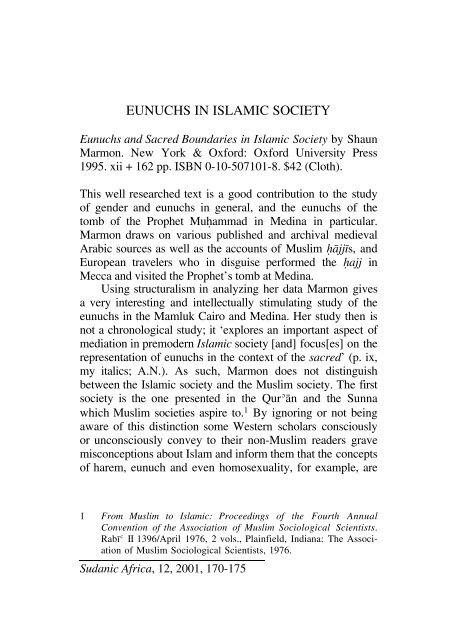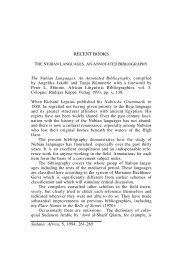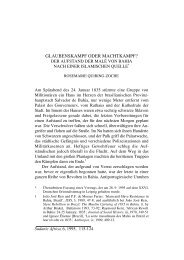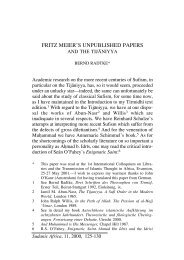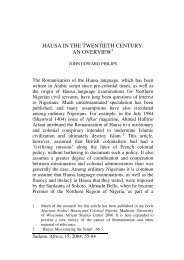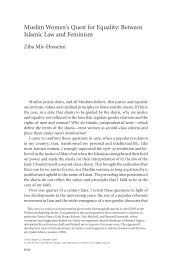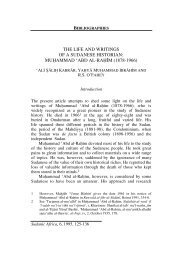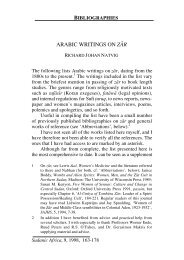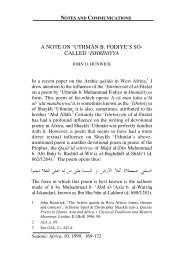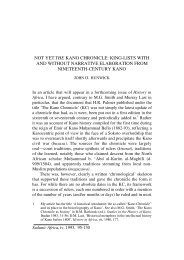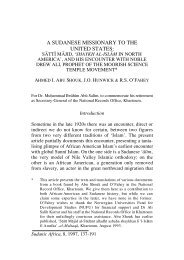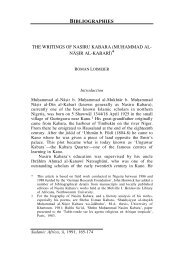You also want an ePaper? Increase the reach of your titles
YUMPU automatically turns print PDFs into web optimized ePapers that Google loves.
172 NOTES AND COMMUNICATIONSMecca and Medina, for example, includes the ‘shrine’, that is,the Kafiba (House of God) and the Prophet’s tombrespectively, whereas the outer circle consists of a specifiedarea around the Holy Mosque in Mecca and the Prophet’smosque in Medina. Marmon considers the sultan himself asthe ‘shrine’ and the Citadel, which is like a city, the outercircle. In addition, she quotes the words of a Mamluktopographer who draws a striking comparison, according toher, between Cairo Citadel and the noble Jerusalem, the thirdholiest sanctuary in Islam. But neither the sultan nor his tombis considered sacred in Islam.Marmon’s attempt to include the boundaries of theharem, the sultan and his tomb under the sacred is, in myview, due to the structural technique she adopts. Likestructuralists she looks for data which can be interpreted tosupport her argument and ignores what contradicts it. Forexample, she argues that the eunuchs guard the religioussanctuary from the danger of fitna (sexual temptation orpolitical disorder). But the eunuchs themselves were involvedin two fitnas causing political unrest, and in one of them tookrefuge in the sanctuary they were supposed to guard, andfought their enemies with firearms. 4As said earlier Marmon focuses on the study of eunuchsas mediators. Since the Mamluk sultanate witnessed theemergence of the eunuchs of the Prophet’s tomb, Marmonbegins her study by examining their role in Mamluk Cairo,where they, being neither men nor women acted assupervisors and guardians of the harem and mediated betweenthem and the master of the house, and could therefore crossthe harem boundary. They also played the same role ofmediation between the sultan and his subordinates includingthe emirs and between his tomb and strangers except recitersof the Qur√applen. Here Marmon could have argued that the4 fiAbd al-Bapplesi† Badr, al-Ta√rıkh al-shapplemil li’l-Madına al-munawwara,3 vols., Al-Madına al-munawwara: fiAbd al-Bapplesi† Badr 1993,II, 384-8 & III, 21-3.
RECENT BOOKS 173eunuchs are well suited for the job because they are ‘dead’since they are biologically incapable of reproduction and aliveat the same time. But she does not, probably because such anargument does not go in line with her next argument. (Seebelow.) In Medina they guard the tomb of the Messenger ofGod, himself an intercessor, and mediate between him and hissuppliants.Though the Prophet passed away it is believed that hisbody is not corrupted by worms and that he lives in this tomba barzakhı life (a life in which time is suspended). Theeunuchs, Marmon argues, are also well suited for serving theProphet’s tomb for they, being castrated before adolescence,never go through the changes of puberty and of course neverreproduce. In other words, they live a life in which time issuspended. No wonder then that in a legend about theProphet’s tomb their roles and the role of a prepubescent childare exchanged. Thus Marmon gives another reason inaddition to the ones already enumerated for the appointmentof eunuchs to serve the Prophet’s tomb, such as theirconcentration in their professions and lack of shahwa (sexualdesire) and therefore their freedom from major ritual impurity.In the preface Marmon states that ‘All observes of theeunuchs, medieval and modern, Muslim and non-Muslim,were outside the category of eunuchs. Many Muslim authorsendow the eunuchs of my story with a voice, but it is oneinformed by a long tradition of hagiography. The eunuchsthemselves maintain a dignified silence’ (p. x, my italics;A.N.). In the epilogue she summaries an interview with theofficer in charge of the affairs of the eunuchs of Meccapublished in al-Yamapplema, a Saudi magazine, in 1990, inwhich he speaks for them and for their counterparts inMedina. She concludes her summary by saying that theeunuchs themselves, the subject of the article, ‘remainsilent…[T]hey continue to maintain their dignified silence’(112). But the present reviewer had interviewed them inMecca and Medina in 1984. The data of the interviews,together with other data, was analysed and published in a
174 NOTES AND COMMUNICATIONSbook, which, incidentally, Marmon does not refer to. 5Regarding the persistence of the eunuchs in Mecca andMedina, Marmon, referring to the above interview in al-Yamapplema magazine, notes that they still exist. In this respectshe comments that, ‘Eldon Rutter would appear to have beena better prophet than Lady Cobbold’ (112). Rutter, a Britishtraveler who visited the Prophet’s tomb in disguise in 1925thought that in spite of the suppression of the slave trade andtheir diminishing number the eunuchs would persist becauseof the active policy of recruitment. Lady Cobbold, a Britishlady who embraced Islam and performed the ˛ajj in 1935 as aguest of the Saudi Government, opined that the eunuchswould cease to exist in a few years for their existence was abidfia (innovation) neither Arab nor Islamic. Her silence onthe eunuchs’ cult is interpreted by Marmon as reflecting theideology of the state—an ideology which condemns the cultof the Prophet and consequently the eunuchs. In connectionwith Lady Cobbold’s view and to show that even Meccanintellectuals do not disapprove of the eunuchs Marmon quotesa Meccan historian, ˘usayn fiAbd Allappleh Bapple Salapplema[Baslamah], who speaks about the eunuchs of Mecca ‘withno trace of disapproval’ (107). But she does not refer toanother Meccan historian and a contemporary of Bapple Salapplema,namely, Mu˛ammad b. ‡applehir b. fiAbd al-Qappledir b. Ma˛müd al-Kurdı who urged the Saudi Government to give themretirement, honour them and replace them by free honourableindividuals. Why? Because ‘most of them are of the commonilliterate people and some are extremely stupid and mentallyweak’. If the government does so, it will, in his view, start agood custom, ‘sannat sunnat an ˛asanat an ’. 6 Personally, I think5 A˛mad fiAbd al-Ra˛ım Naßr, al-Aghawapplet: Dirapplesa ta√rıkhiyyamuqapplerina li-aghawapplet al-masjid al-˛arapplem bi-Makka wa’l-masjidal-nabawı bi’l-Madina, Khartoum: Institute of African and AsianStudies, University of Khartoum 1986. For the availability of thebook in the U.S.A., consult .6 Mu˛ammad b. ‡applehir b. fiAbd al-Qappledir al-Kurdı, al-Ta√rıkh alqawımli-Makka wa-bayt Allappleh al-karım. IV, n.p., n.d., 241.


